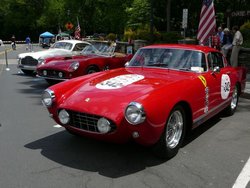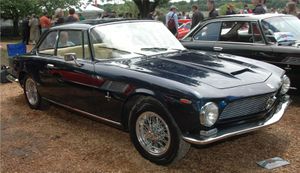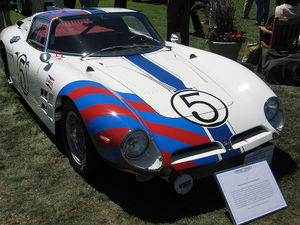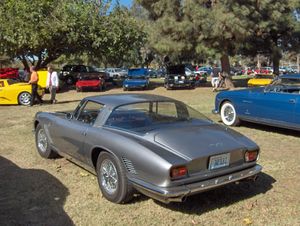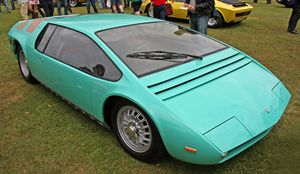Bizzarrini
| Bizzarrini S.p.A. | |
|---|---|
| Foundation | 1964 |
| Defunct | 1969 |
| Fate | ceased production |
| Location | Livorno, Italy |
| Industry | Automotive |
| Key people | Giotto Bizzarrini, founder |
| Products | Automobiles |
| Parent | |
Bizzarrini S.p.A. was an automotive manufacturer in the 1960s. Founded by former Alfa Romeo, Ferrari and ISO engineer, Giotto Bizzarrini, the company built a small number of highly developed and advanced sport and racing automobiles before failing in 1969. Originally named as Prototipi Bizzarrini s.r.l. and changed the name to Bizzarrini S.p.A. in 1966. The marque has been revived with a number of concept cars in the 2000s.
Bizzarrini, The Man
Mr. Giotto Bizzarrini was born in Livorno, Italy in 1926. He was the son of a rich landowner and came from a good family with strong roots in Tuscany and the city of Livorno. His grandfather, also named Giotto Bizzarrini, was a biologist who had worked with Guglielmo Marconi on his inventions, especially the radio, following which one of the Livorno Library sections was named The Bizzarrini Library.
Giotto Bizzarrini graduated as an engineer in the University of Pisa in 1953. He taught briefly before joining Alfa Romeo in 1954. He worked for Alfa Romeo, Ferrari, Lamborghini, ISO and later built cars under his name. He also developed advanced designs for GM like the AMX Sciabola project, and as style and technical consultant for GM in Europe and USA, top Japanese motorcycle marques and well-known designers such as Pininfarina.
Today, he is still very busy, teaching and collaborating with the Roma University developing advanced projects and designing, building and developing his own sport cars. He often said: "I'm not a car designer, I am a worker".
Bizzarrini at Alfa Romeo
In August 1954 he started as an engineer at the 'Servizio Esperimenze Principali', where worked with Ing. Nicolis. He was assigned to the development of the Alfa Romeo Giulietta chassis.
Bizzarrini joins Ferrari, the golden years
He left Alfa in 1957 and went to Ferrari. A legend says that Bizzarrini arrived at Maranello to an interview with Enzo Ferrari driving one of his specials, a Fiat 500 based sport car called The Machinetta, that still exists today. Ferrari was truly impressed by the little car, and Bizzarrini intermediately joined Ferrari, were he was quickly promoted to controller of experimental, Sports and GT car development.
He worked five years at Ferrari as chief engineer. He also worked as developer, designer and skilled test driver. The Ferrari 250 GT 2+2/GTE, the 3 litre Testarossa V12 engine, the Ferrari 250 TR or Testarossa and the Ferrari 250 GT SWB (Short Wheelsbase Berlinetta or Berlinetta Passo Corto) were influenced by his ideas and technical solutions. For one of the most successful Ferrari racing series, the Ferrari 250, Bizzarrini worked hard to develop the chassis, engines and advanced dynamic solutions.
Ferrari 250 GTO
His masterpiece at Ferrari was the 1962 Ferrari 250 GTO. He was first involved with the 250 GTO project in 1960. Ferrari wanted a GT racer with better aerodynamics than the previous 250 GT SWB. The SWB was a great racer but with poor wind penetration coefficient. Jaguar had just launched the Jaguar E-Type and Ferrari need a top contender in the tracks.
Tests started secretly with a Ferrari 250 GT unit, bodied by Mario Boano, with chassis number #2643GT, Mr. Bizzarrini's personal car. This car was developed and was used as a test mule for technical solutions later seen in the GTO. This car was known as the Bizzarrini Ugly Duck. Experiments with SWB showed a great loss power due poor aerodynamics. Then Bizzarrini developed a small front surface and longer bonnet to improve speed and reduce front lift tendency at high speeds. Bizzarrini also moved the engine well back into the chassis to improve weight distribution and handling. He also lowered the engine, using a dry sump lubrication system. The result was the Ferrari 250 GTO, one of the greatest sport cars ever.
In 1962, when the GTO was launched, it was the ultimate in aerodynamics. Carroll Shelby 289 AC Shelby Cobra cars were a little faster on slow tracks, but the GTO achieved a superior top speed and dominated the GT class. When Shelby developed the Cobra Shelby Daytona (a car influenced by the GTO shape) it was too late to stop Ferrari victories. And then, Ferrari was ready to fight with the revolutionary Ferrari 250 LM, the first rear engined GT from Maranello.
In 1961, he was one of the "famous five" engineers who left Ferrari. This is known as the "Ferrari night of the Long Knieves" [1]. It was caused because Ferrari wanted to reorganise the engineering staff. Bizzarrini left Ferrari and founded with the rest of ex-Ferrari engineers (Carlo Chiti, and others) ATS, Automobili Turismo e Sport company to build a Formula 1 single seater and a GT sport car, the A.T.S. Serenissima.
Count Volpi, the specials and ATS
In 1962, Bizzarrini was hired by Count Giovanni Volpi, owner of the SSS, Scuderia Serenissima Republica di Venezia, to uprate a Ferrari 250 GT SWB to GTO Specification. Ferrari was upset with Volpi and refused to sell him a GTO.
Bizzarrini applied all the ideas from the GTO and developed with Piero Drogo of Carrozzeria Sports Cars in the Modena works an aerodynamically advanced body, even lower than the GTO, with the roof line dramatically extended to the rear end, then abruptly truncated following the Kamm aerodynamic theory. The car was completed in just 14 days. This car, chassis number #2819GT was called the Ferrari Breadvan, and still exists today. Car was raced successfully but could not beat the works GTO's because of the lack of a five speed gearbox. At least another two 250GT series cars were developed by Bizzarrini, Piero Drogo, and team-mates Neri and Bonacini to GTO spec and received distinctive bodies with similar advanced shapes.
Lamborghini Engine
In 1963, about 20 kilometres from Modena, in the small town of Sant'Agata Bolognese, Automobili Ferruccio Lamborghini SpA was born. The legend said Ferruccio Lamborghini was not happy with some cars purchased from Enzo Ferrari. He went to see The Man, and Lamborghini explained his thoughts about how sports cars should be built. Ferrari listened to Lamborghini and then suddenly threw Lamborghini out of his office. Legend said Ferrari was not very happy hearing a farming engineer giving him lessons about building sport cars.
Ferrucio Lamborghini asked Bizzarrini to design a new engine through Societa Autostar, created in 1962, before Bizzarrini left Ferrari, with the objective to get freelance engineering projects. With the help of seasoned engineer Bizzarrini and up-and-coming engineers Giampaolo Dallara and Paolo Stanzani, Lamborghini emerged onto the world GT cars scene with the Lamborghini GTV, that later became the 350GT. In 1966, his company gained even greater recognition with the unveiling of the Lamborghini Miura which uses the FOHC four litre version of the Bizzarrini designed V12 engine.
Iso: from refrigerators to Grand Turismo
Bizzarrini worked since 1964 for Iso Rivolta and developed three models: Iso Rivolta GT, Iso Grifo both A3L and A3C versions. His work was to develop a pressed steel frame chassis for Iso cars. Renzo Rivolta hired him as consultant to the Iso Gordon GT project which became the Iso Rivolta GT. The Iso Gordon GT prototype was developed from the Gordon-Keeble. The Gordon Keeble GT was designed in 1960 by Giugiaro. Bizzarrini tested the car and was amazed by the smooth powerful V8 Corvette engine and the rear De Dion tube used for the GT:
'Rivolta had me test the prototype. I liked its De Dion tube and specially the Corvette engine. It was first time I had driven one. It was superior to Ferrari's engines, having the same power but with a more immediate throttle response.'
Iso Rivolta GT was a Giugiaro designed four seater with beautiful body, speed, comfort and handling. Iso Rivolta GT was a successful car for ISO, with 799 units sold. Powered by a 327ci V8 Chevrolet Corvette engine with a classic de Dion rear suspension design with pressed-steel monocoque bodywork over press steel frame chassis. Unveiled to press in 1963, production continued until 1970.
ISO Grifo
The Iso Grifo was a monstrous idea for a super coupé. It was officially named the Iso Grifo A3L. The L came from Lusso. Presented at the Turin show of 1963, it was based on a shortened Iso Rivolta GT chassis. Grifo was the result of two genii at work together: Bizzarrini and Giugiaro. Grifo epitomised the Italian 1960s style with his handsome low and wide handmade bodywork. 412 units were built until the factory closed in 1974. It was the fastest production car tested by Autocar Magazine in 1966 with a top speed of 160mi/h. Later versions of the Grifo were powered by a massive Chevrolet Corvette 350bhp "big block" engine. These 90 handbuilt units are distinguishable by the ugly raised "pagoda style" scoop bonnet. Some of these Iso Grifo 7 Litri units were rebuilt some years after with even bigger engines.
The idea of Bizzarrini was to use the 3AL cars for competition. The competition versions of the Grifo were named Iso Grifo A3C, C for Competizione or Corsa. A new lightweight riveted aluminium body was designed and built by Piero Drogo. It was an aggressively designed machine, oriented to endurance races. It uses normal ISO underpinnings but the engine was moved further back in the chassis frame than the Grifo A3L, protruding well into the driver's cabin, fitted with hot cams and fed by four big Weber carburettors, giving more than 400 bhp.
Around 29 A3C sport cars were built under the ISO name. Five of these 29 cars were bodied in plastic/fiberglass by Piero Drogo at Carrozzeria Sports Cars in Modena. A3C's were widely raced. Some cars entered the 1964 and 1965 Le Mans 24 hour, 1965 Nürburgring 1000 and 1965 Sebring. It achieved a Le Mans class win in both years and a 9th overall in 1965 with no factory support. A3C's were one of the fastest cars on LeMans' Mulsane straight in both years.
Bizzarrini S.p.A.
Due to the complicated deal with ISO, Bizzarrini left in 1964 and founded Societa Prototipi Bizzarrini (Bizzarrini S.p. A), which produced some 140 cars through 1969 at its Livorno factory.
5300 Strada
In 1966 Bizzarrini S.p.A. released a stunning street legal Grifo A3C as the Bizzarrini 5300 GT Strada (or Bizzarrini 5300 GT America, depending on the market). The body shape and mechanical parts were the much the same as the Iso A3C's, resulting in a power-packed yet sensuous coupe under 40" in height.
At least three 5300's were turned out as beautiful Style Italia designed spyder/targa versions, all of which survive.
Bizzarrini 1900 GT Europa
Main article Bizzarrini Europa
Bizzarrini also managed a scaled-down 5300 GT project. Designed for GM-Opel, it was based on Opel 1900 platform. Bizzarrini's proposal was more aggressive and good looking. It was a baby-looking 5300 GT. The production Opel GT was designed by factory stylists and was less aggressive but still beautiful. Bizzarrini then decided to build the car himself. Around 17 prototypes were completed. The car is officially named as the Bizzarrini 1900 GT Europa. One of these cars has a barchetta body. Some cars are powered by 1300 and 1600 four cylinder engines sourced from GM, Alfa Romeo and FIAT. There is even a highly developed racing version with SPICA fuel injection system.
Bizzarrini P538S
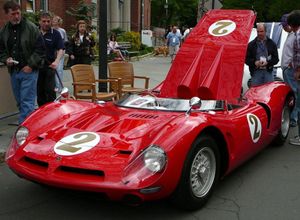
Bizzarrini's advanced ideas emerged again with the superb Bizzarrini P538S, P for posteriore, 53 for the 5300 cc Corvette engine, 8 for 8V engine and S for Sportcar. The first V-12 car was ordered by USA racer Mike Gammino.
This ultra low barchetta raced in the 1966 Le Mans (DNF) and was entered in 67 even but did not start (DNQ). In 1966, after a spin at the very start line, it lasted less than a half an hour and retired by a cracked oil pipe. During the short race time, the P538 was clocked as one of the fastest cars down the Mulsane straight.
In 1968, Giugiaro rebodied one of the P538 as the famous Bizzarrini Manta. After some years in Sweden, it was dismantled for an extensive restoration. Later featured in various classics cars events, it now resides in USA.
Post Bizzarrini S.p. A
Bizzarrini P538S Replicas
Officially three or four chassis were originally built in period, but a total of ten (or more) chassis are in existence today. At least two of these are Lamborghini V12 powered. These V12 powered cars were truly the long waited Bizzarrini dream: his own engine and own chassis.
In the late 70's and 80's, Salvatore Diomante, Bizzarrini's partner, built two P538S replica (or re-editions), commissioned by Luciano Bertolero. Later in the 80's an 90's, more chassis and even completed cars surfaced from time to time, some of them claiming to be original cars, or even the "Le Mans Car". Classic Car consultants talk about six or more chassis. One of these replicas were built using a DeTomaso Pantera chassis and Ford V8 engine, wearing tall ram air trumpets like a CanAm cars.
Bizzarrini BZ-2001
In 1990, Bizzarrini was involved in the design of a one-off supercar model. Based on Ferrari Testarossa bits, Bizzarrini and his team designed a superb car. The Bizzarini BZ-2001 is the true follower of the P538. The car was the first one of a supposed production run, but only one more car was completed.
Picchio Barchetta
In 1989 a group of young friends living in Ascoli Piceno, with a strong passion for motor sport, had the idea to establish a company constructing "copies" of the cars manufactured in the past by Giotto Bizzarrini. During their first encounter, the Tuscan motor genius expressed a kind of animosity towards this idea; he refused to support the project and he turned the group of friends out. Nevertheless, their motivation was so strong that, after a short briefing of about half an hour, they presented an alternative proposal: to construct a sports car. The result was the Picchio Barchetta, powered by BMW engines. The cars were successfully raced in the Italian Hillclimb Championship and Italian Sport Championship.
Bizzarrini Kjara
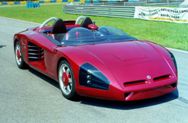
The Kjara project was born in 1998. The Scuderia Bizzarrini built this sport barchetta in close collaboration with Leone Martellucci of University La Sapienza of Roma. The car is powered by a parallel hybrid propulsion system with a 2.5 litre TurboDiesel LANCIA engine and a 40 kW AC electric drive; it was shown at Turin Motor Show 2000.
Bizzarrini today
Mr Bizzarrini is still busy with personal projects and conferences.
At the 2005 Geneva show, the new owner of the marque Bizzarrini showed the new GT Strada 4.1 concept. It's a two-door GT with a 4.1-litre 550bhp plant (maximum speed - 360km/h, 0-100 km/h in 3.8 sec.) and was planned for production in 2007.
2008, Giotto Bizzarrini is working in Livorno building replicas P538 for american customers
See also
Bizzarrini Car Models and Pics
Sources
- Unofficial Bizzarrini Web Site: [2]
- Jack Koobs de Hartog/ Rodolphe de Biolley/ Olczyk Philippe: Bizzarrini: The Man, his Projects and His Cars. ISBN 9952-800207.
- Winston Goodfellow: Iso Rivolta, The Man, The Machines. Motorbooks International 2001. ISBN 8879112686.
- Flavio Campetti: Da Iso a Iso Rivolta. Giorgio Nada. ISBN 18879113194.
- ISO and BIZZARRINI Gold Portfolio 1962-1974. Brookland Books. ISBN 1855202395.
- Eliguisz Mazur ed.: "World of Cars - Worldwide Car Catalogue". Media Connection SP. Z O.O ISSN 1734-2945
- For chassis numbers database reference, [3]
External Links
Send what you have to:
| Car Information and Photos by Marque: A - B - C - D - E - F - G - H - I - J - K - L - M - N - O - P - Q - R - S - T - U - V - W - X - Y - Z |
| Motorcycle Information and Photos by Marque: A - B - C - D - E - F - G - H - I - J - K - L - M - N - O - P - Q - R - S - T - U - V - W - X - Y - Z |

